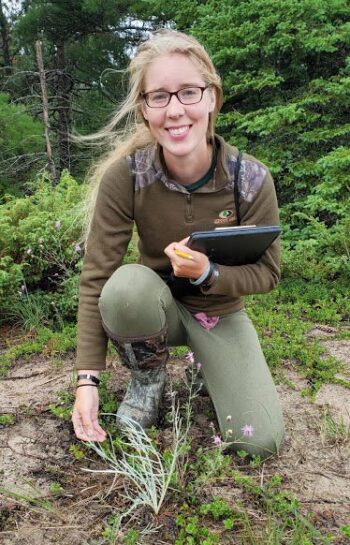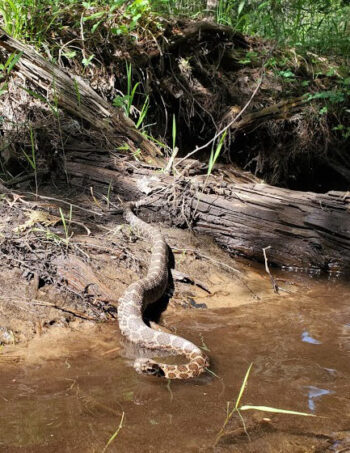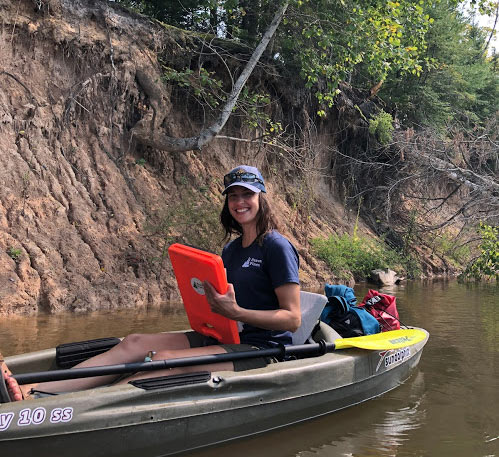NORTHEAST MICHIGAN – The river restorations that Huron Pines carries out on watersheds across Northern Michigan are the culmination of years of information gathering and planning. Before we restore a road/stream crossing site, we gather data to understand the negative impacts an old culvert is having on a river and to predict how a new crossing structure will benefit the health of a river and its trout.
In the same way, the choices we make about our land stewardship efforts are also based on extensive data collection by staff, partner organizations and citizen scientists. The more information we have, the easier it is to prioritize where we should focus our efforts and accurately estimate the time and resources necessary to make the biggest impact on the region.
In 2020, to better meet the demands of our region, we reorganized our 12-county invasive species network into two Coastal and Heartland Invasive Species Networks. The networks are supported in part by the Michigan Invasive Species Grant Program and each have their own coordinators and field technicians, to provide greater capacity and better services tailored to the unique needs of each landscape.
Working collaboratively, partners in the Huron Coastal Invasive Species Network and the Huron Heartland Invasive Species Network engage communities and lead them in a strategic and coordinated approach to invasive species management, including awareness, prevention, control and restoration.

By land and by sea, we’ll rack up the miles to gather data that’s critical for our decision-making process.
This summer, our Heartland invasives team will again fire up their four-wheelers to complete a two-year effort of surveying 700 miles of motorized trails and 65 forest campgrounds for invasive plants. Data gathered during this inventory will help drive future work to restore these recreation areas so that native plants and wildlife can flourish. This project, funded by the U.S. Forest Service’s Cooperative Weed Management Area program, covers Crawford, Montmorency, Ogemaw, Oscoda, Otsego and Roscommon counties.
This trail and campground survey is an opportunity to also look at sites where trails intersect streams to help determine whether future projects could restore those waterways with improved crossing structures.
“I’ve been surprised at the variation in terrain and habitats I encounter in one trail loop,” said Stewardship Program Coordinator Shelby Bauer about the first half of the trail survey last year. “It has really been a unique and different way to experience Northern Michigan.”
From June to September, our invasive-plant inventory and treatment will take us to parts of Northern Michigan that are home to some of the rarest plants and animals of the Midwest. Among these places are the 147,000-acre Camp Grayling National Guard training facility that spans Crawford and Kalkaska counties. and the 4,118-acre Negwegon State Park on the border of Alcona and Alpena counties.
These efforts will help protect and restore native habitats for Voss’ goldenrod, a rare Michigan endemic plant found at Camp Grayling; and Pitcher’s thistle, a federally threatened dune plant growing on the Negwegon coast and almost nowhere else on Lake Huron.

We’ll also be teaming up with local groups to treat invasive species along the entire North Branch of the Au Sable River, having spent long days surveying some of Northern Michigan’s most scenic stretches of river to find the places where we’ll need to focus our efforts in order to keep them scenic.
By boat, kayak and canoe, our river and lake inventories will take us along 22 miles of the Thunder Bay River and 60 miles of shoreline at Hubbard Lake, Lake Winyah and Fletcher Pond in 2021 as we survey and monitor for invasive plants.
If you see us out this season, feel free to give us a wave and a smile. If you’d like to get involved, learn how to identify and report invasive species in your area via the Midwest Invasive Species Information Network by visiting our website, huronpines.org/invasives.


